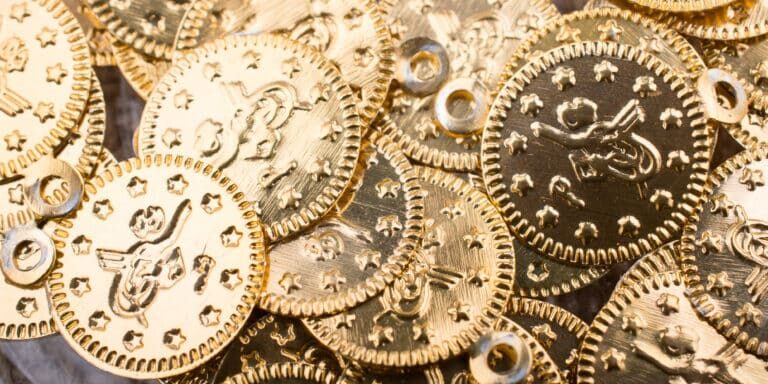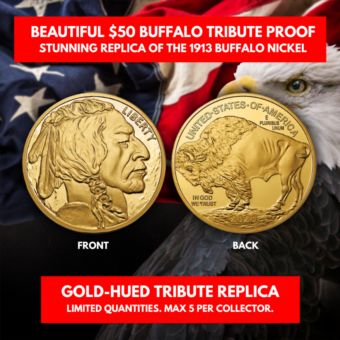
How To Spot Fake Gold Coins
For as long as people have held gold, counterfeiters have been working to fool us with fakes. Gold is one of the most valuable natural resources on earth and has been for an incredibly long time. As the most long-standing form of wealth we have, it’s not surprising that so many try to cheat their way into an easy payday. Unsuspecting investors and rookie collectors can be easily hoodwinked by counterfeiters into spending their hard-earned cash on fake precious metals, and this is a huge problem for the coin market.
If you’re not an expert on gold and silver, some counterfeit coins can be incredibly convincing. Their small size and affordable nature make coin rounds much easier to sell than larger solid bars, and unfortunately fake gold penetrates the market everywhere. If you’re viewing a coin and considering making a purchase, it doesn't matter whether it’s online or in-person; you need to know how to spot fake gold.
There are just a few simple techniques you can use to validate a potential gold coin, and these can greatly reduce your chances of falling victim to counterfeit gold. Read on to discover the best methods you can use to check if a gold coin is real before you buy it, and even how to test it in more detail after the fact. We’ll also share some fascinating details about the history of counterfeit gold, and how it has affected the way we buy and sell gold coins today.
The Origin of Counterfeit Gold Coins
The first-ever gold coins were minted in present-day Turkey several thousand years ago and were made from a naturally occurring gold-silver alloy called electrum. As the coins became more popular and technology advanced, improvements were made to the refinement process so that pure gold coins could be produced.
Ever since we began using the first-ever gold coins as currency, counterfeiters have aimed to fool others with fake money. The temptation of easy money is just too irresistible for some to handle, even though the price for producing counterfeit gold is steep. In the United States, crooks convicted of making fake money can face large fines and significant jail time.

When you're considering the purchase of a gold coin, find the registration number if the coin is certified or graded.
How are Fake Gold Coins Made?
The way in which counterfeit coins are made has changed over the centuries, however, much of the methodology remains the same. A base metal, one which is low in value, is covered in a thin layer of gold. Then, a die stamp created using an authentic coin is used to impress the design on the fake. This is one method of producing a convincing coin, but there are a few others you might come across.
Another technique for creating counterfeit gold involves using the original coin to make a mold out of clay or ceramic. Then, the alloy is poured into the cast to set. The coin is then coated in a thin layer of gold or silver using a process called fire gilding. This involves using mercury to adhere the gold to the fake coin. As you can see, the majority of counterfeit gold coins are produced using trace amounts of the real precious metal, just enough to fool you into overpaying for scrap metal. However, anti-counterfeiting measures are getting stronger every day and the fight against fake gold is ongoing. All it takes is for investors to educate themselves before making a purchase, and avoiding falling victim to fakes is easy.
The Rise of Modern Anti-Counterfeiting Measures
All the coins produced by government mints today, whether they’re bullion, currency, or collectible, feature marks and technology to fight against counterfeiters. Every year, national governments implement new techniques to reduce the impact of gold counterfeiters and help the bullion market to stay alive. Everyone, from the institution of the U.S. Mint, down to the individual buyer, has a responsibility to help fight against fake precious metals. Left unchecked, these falsifications could destroy the power and value of precious metals, so it’s a good job so many resources go into preventing this eventuality.
The American Gold Eagle and Silver Eagle are two of the most widespread bullion coins in the world. For this reason, they’re also among the most commonly counterfeited, as fakes can hide in a sea of genuine gold. Next year in 2021, the United States Mint has planned a redesign for the Gold and Silver American Eagle coins which will make them much more difficult to imitate. The US Mint has added an undisclosed number of new security features to the coin, but we expect this advanced technology to significantly assist anti-counterfeiting efforts.
Gold Canadian Maple Leafs are also a very common coin to fake. In fact, a recent survey by the Anti-Counterfeiting Task Force has found these coins from the Royal Canadian Mint are amongst the most popular for counterfeiters. Gold Maple Leaf coins make up around 25% of reported fakes in the US, while the South African Krugerrand represents about 30%. Canada’s mint puts up a serious fight with those who would fake their coins, and are constantly working to improve their security.
The Royal Canadian Mint employs a system called DNA, which they claim is the most advanced coin authentication system. The term stands for digital non-destructive activation, a technique that can separate real Canadian Maple Leaf coins from fakes without even touching the coin’s surface. This technology uses a specialized reader to capture encrypted image codes from the coins and match them with their database to validate the origin of the coin.
Canada is also the producer of some of the finest precious metals coins in the world, so .9999 purity is much harder to fake. Additionally, microscopic laser engravings of privy marks are added to every minted coin, as well as intricate radical lines that are incredibly difficult to replicate. This detailed laser engraving technique has also been adopted by the British Royal Mint and Perth Mint in Australia, which is a testament to its effectiveness.
How To Spot Fake Gold Coins
Watching old western movies about cowboys and gold mines might lead you to believe that biting down on a gold coin is an effective way to validate it. Unfortunately, this only works in the movies and isn’t a functional test in the real world. This concept originated from when early miners would bite into ore in order to separate soft pure gold from much harder pyrite, but sadly this method won’t help you spot a fake American Eagle.
There are plenty of other much more scientific ways that you can test if a gold coin is fake. First, we’ll share some tips on how you can spot fake gold coins before buying them. Obviously, it’s always preferable to find out before you make a purchase, so using a few simple ideas you can eliminate a lot of fakes easily. The most convincing counterfeit gold coins may pass these tests, in which case you’ll only discover your gold is fake when you validate it at home. After we share our advice on spotting a fake gold coin on the market, we’ll tell you how to test your purchase and find out the true metal content.
Visual Inspection
You’d be surprised how many secrets can be revealed if you just take a long, hard look at a coin. We recommend taking along a magnifying glass to coin auctions or bullion dealers, so you can examine the coin in detail before you decide to buy. There are numerous visual clues that can indicate the validity of a gold coin, all you need is to know what to look out for.
The smallest details in a coin usually have the most tales to tell, if the gold is counterfeit of course. Look for uneven lettering, or a slight difference in the typeface used. Missing numbers and misspelled words are surprisingly common in fake counterfeit coins, so you can use them to spot a fake straight away. Even the amount of space between letters and numerals can be a giveaway for a counterfeit coin.
The color of a gold coin can also indicate if it is real, as can the general appearance of the metal. Many fakes are cast instead of pressed, which leaves a grainy effect on the surface of the coin. Fake metal may appear too shiny or rather dull, and the coins may be slightly irregular in shape. All of these details are easy to spot under magnification, and you just need a photograph to compare to the genuine article.
Weight
One quick way to test if a gold coin you’re considering is to weigh it, as fake gold often will not have the same mass as a genuine coin. Not all gold coins weigh the same, so you should know how much the specific coin you’re considering is supposed to weigh. The most popular bullion rounds are 24 karat one-ounce sovereign coins, a dense and heavy piece of metal that weighs exactly one troy ounce.
However, many common investments like the Gold American Eagle are made up of 22-karat gold, so they weigh more than a troy ounce. This is because the gold is alloyed with another material to make it stronger, and of course this increases the weight. Coins of pure quality will weigh an exact troy ounce or 31.1 grams, but this isn’t the only acceptable number. South African Gold Krugerrands weigh 33.3 grams, while other popular coins like the $20 Liberty Head read 33.43g.
So, we know how important it is to do your research before setting out to buy a coin. You need to know in advance the exact weight of the specific coin you’re thinking about buying, so you can validate it on the spot. Whenever you go to look at precious metals coins for purchase, bring along an accurate portable digital scale. One of these is an excellent investment if you plan to buy valuable coins, as checking their weight is the first step towards validating your new investment.
Size, Diameter, and Thickness
As weighing a gold bullion coin was, for a while, the easiest way to spot fakes, counterfeiters have begun to take more attention in their deception. They noticed that many coin buyers now weigh potential purchases, so much more effort now goes into ensuring that fake gold coins have the correct mass. Unfortunately for them, the weight of the false metal doesn’t match that of real gold, so adjustments must be made in other areas.
In order for a fake gold coin to weigh the same as the genuine article, the size of the coin has to change. Either the diameter or thickness of a false gold or silver coin is adjusted so that it has the correct weight, and this is slightly more difficult to spot. As with checking the weight, you need to know the exact specifications and dimensions that your potential investment should be.
It’s very difficult to estimate by eye if the dimensions of a coin are correct unless the fake you’re seeing is especially poor. A caliper is a simple tool which just like a portable scale can be bought at low cost, and is well worth the investment to help validate your gold coins. You should use calipers to accurately measure both the diameter and thickness of a coin before buying, and ensure they match the mint’s description.
Price
Price is a massive indicator of validity when it comes to precious metals as if it seems too good to be true; it probably is. Any new investor who happens across a deceptively cheap piece of solid gold might be tempted into making a purchase, but precious metals investments are worthless when they turn out to be scrap. Always expect a markup when buying from bullion dealers or independent sellers. Anything cheaper is a sign of trouble.
Most gold coin dealers will sell bullion at between 1.5 and 10% over the spot price of gold. For small and rare coins, the premium could be even greater. These additional costs over the value of the metal content account for the refining and minting process, transportation costs, and the profits of everyone along the way. If you’re offered a gold coin at a price below the current spot, there’s either a hidden charge to make up for those losses, or you’re being offered a fake.

It's always a good idea to check the real dimensions of a particular coin before buying.
7 Fake Gold Red Flags
Here are 7 easy indicators you should be able to spot straight away, which hint that a gold coin is counterfeit:
1. Too light: If your coin doesn’t feel dense and heavy, it’s probably not gold.
2. Too big: Counterfeit coins are often larger to match the weight of real gold.
3. Grainy or blemished surface: Real gold is unreactive and shines forever.
4. A seam along the rim: Signs of an improper minting process.
5. Mistakes in the lettering or details: Real bullion coins are strictly quality-checked.
6. Magnetic: Pure gold is a non-magnetic material.
7. Bargain prices: Your coin dealer is unlikely to want to lose money.
Avoiding Counterfeit Coins
Unfortunately, counterfeiters have been making money off unsuspecting investors for centuries, and this is unlikely to stop any time soon. Even as anti-counterfeiting technology advances, so does the expertise used to hoodwink precious metal buyers. Even veteran coin dealers can be fooled, so it’s more vital than ever to be aware of the dangers of fake gold.
As more of the global population realizes why they should invest in gold, the potential for counterfeiters to find business is rising. Fake gold saturates the market, bringing down the overall value of precious metal coins, and risking the destruction of this age-old industry. Investors spend thousands on counterfeit gold every year, so it’s obvious why knowing how to spot fake gold is important.
Although the dangers are out there, they are easy to avoid when you’re prepared. You should be able to avoid the vast majority of fake gold coins by using the advice we’ve shared in this article, meaning you can make much smarter investments in the future. All it takes is a little advance planning and every trip to the coin dealer will be a success. You need a few supplies to successfully complete the tests we’ve listed, but they are inexpensive and well worth the investment.
A magnifying glass, a small accurate scale, and a pair of measuring calipers are all the tools you need to be a successful gold coin buyer. In addition, you need to do thorough research beforehand, and taking along the specifications and an accurate photograph wouldn’t hurt either. Armed with these supplies, you should be able to expertly validate the size, weight, and appearance of a gold coin.
Without completing much more intrusive tests, there’s no way that you can guarantee a gold coin is valid. However, these tests involve solvents, and scratching, and cannot be completed before you make your purchase. You can find out later if your gold coin is fake, but the information is useless once money has changed hands. Checking the weight and dimensions against official specifications is the best way to validate a coin without damaging it. This, in addition to thorough inspection by eye, should be rough to help you spot fake gold coins.











